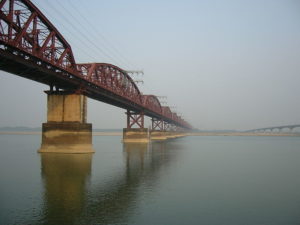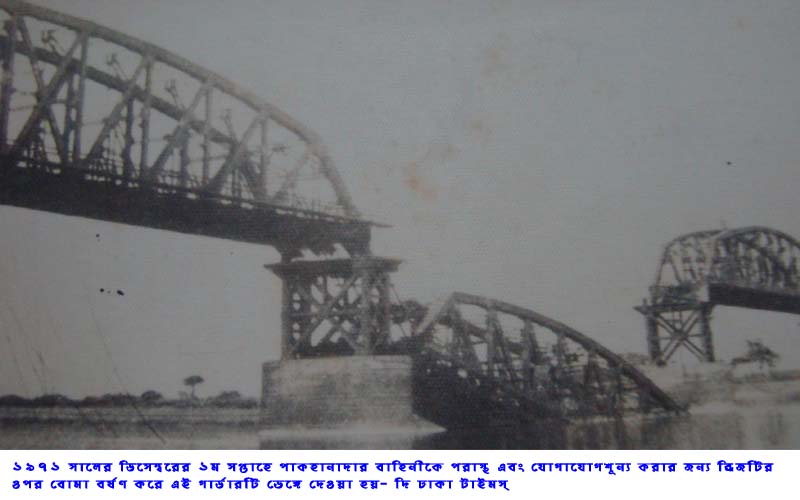The Dhaka Times Desk Pakshi Hardinge Bridge, which is known as the largest railway bridge of the country and the Asian continent, has completed 100 years. The warranty after construction was 100 years which has already expired. It is now only the pride of our country as a witness of time.

123 years ago in 1889, the British government planned to build a railway bridge over the Padma river with the aim of increasing the extent of rail communication in the Indian subcontinent. In particular, the process of building a bridge over the Padma river on the border of Kushtia and Pabna districts of present-day Bangladesh was initiated to facilitate travel to Darjeeling and the eastern states of Assam in India.
Talking to bridge experts and seeing the nameplate installed in 1912, Hardinge Bridge celebrated 100 years in 2012. At that time, Golapnagar Saraghat was the sheep village of present day Kushtia on the east bank of Padma river. On the other hand, Saraghat in Ishwardi Upazila of Pabna district was one of the largest river ports in the country. Where domestic and foreign big steamers, launches, barges, moneylender boats etc. crowded in the 16 ghats of Sarabandar. In this situation many launches, steamers sank in Pramatta Padma, causing loss of life and damage to goods. Considering the real context, the undivided Government of India then proposed to build a bridge over the Padma river with the aim of extending the railway from Bhat Kathihar to Amingaon Amanura to facilitate domestic and foreign tourist travel and freight transport in Darjeeling and the eastern Indian state of Assam. Based on that proposal of 1889 for the construction of the bridge, Match F. J. Spring prepared a detailed report after extensive study for four years from 1902 to 1905. After a long survey, information about the feasibility of building a bridge south of Saraghat was provided to the government and in 1907 the plan was finalized to build a bridge over the Padma river between Bheramara and Ishwardi upazilas of Pabna in Kushtia. After the construction of the bridge was approved in 1908, the British engineer Robert William Gales was appointed as Engineer-in-Chief, Sir SM Bendelegh for the original design of the bridge and Sir Francis Spring for the project and Braithwaite and Kirk as the contractor.
Then the wells were drilled, 15 spans were installed, each bearing to bearing 345 feet and a half inches in length and 52 feet in height. Each span weighs 1,250 tons. 1,300 tons including rail line, also has land span on both sides with a distance of 75 feet. The total length of the bridge is 5,894 feet (a little more than 1 mile), 2,99,000 tons of brickwork, 3,000,000 tons of steel, 1,70,000 drums of ordinary cement and 1,200,000 drums of kildcement (with special adhesive) were used in the construction of the bridge. From 1,000 yards downstream to 6 kilometers upstream of Hardinge Bridge, 16 million cubic feet of soil and 2,33,70,000 cubic feet of stone were used to construct the guide dam. At the construction site of Bheramara-Pabna Pakshi Hardinge Bridge in Kushtia, which is about 3 kilometers wide, 1.81 kilometers of river was narrowed by damming on both sides and during the construction of Hardinge Bridge, the water carrying capacity of the river in the alignment of the bridge stood at 25 lakh cubic feet. Source: Dainik Amar Desh.
Although the number of workers was low before 1912, the number of workers on the project was increased from February 1, 1912. Since then, 24,400 workers worked tirelessly for 5 years and completed the bridge at the end of 1914. On January 1, 1915, a freight train was run experimentally through the down line. After 2 months, passenger trains started running on double line on March 4. At that time, the then Viceroy Lord Hardinge opened the bridge for trains. The bridge named after him was named Lord Hardinge's Bridge.
At that time, the total cost of constructing the bridge was 3 crore 51 lakh 32 thousand 164 taka. Out of this, 1 crore 80 lakh 6 thousand 796 taka for span, 5 lakh 19 thousand 849 taka for land span, 94 lakh 8 thousand 346 taka for river speed control and 71 lakh 55 thousand 173 taka for railway line on both sides. If you want to calculate the value of money, you can understand the words of some visitors of the village, 'looking at the big iron girder of the bridge, they commented that it cost five hundred rupees!' There is a saying that 1 taka was used to get 16 maunds of rice at that time.
Why is Hardinge Bridge unique?
According to various statistics, the reputation of the bridge built by the British government carries a huge identity. There are many bridges and bridges in the world that are taller than Hardinge Bridge. But this bridge is unsurpassedly famous for some reasons. The first reason is that the deepest water under the bridge is 160 feet or 192 MSL below the lowest water mark. Among them, pillar number 15 well is installed 159.60 feet below the low water level and 190.60 feet below the maximum level i.e. 140 feet below the mean sea level. It was the deepest such foundation in the world at the time. The remaining 14 wells are installed 150 feet below ground. The second reason is that the river training system for this bridge is also unique in the world. The bridge was so beautiful and attractive that the British Chief Engineer Robert William Gales was awarded the title of Sir as a reward for the achievement.
The story of a girder breaking
During the 1971 War of Independence, the bridge was bombed to defeat and cut off contact with the Pakistani forces. (Hear 1971  In the first week of December, the allied forces i.e. Indian forces bombed and destroyed the bridge to defeat the Pakistani invaders. Due to which the country became independent within a short period of time. Many people think that the decision to break the bridge that day was also a correct decision during the independence of the country) as a result of which one end of the 12th span (girder) from the top of the pillar fell into the river. The lower part of span No. 9 is damaged. Due to the strategic reason of not allowing the Pak forces to enter South Bengal, communication was cut off by placing dynamite on top of the pillars and under the girders and bombarding them from above. As a result, South Bengal was cut off from North Bengal and the bomb that damaged the Hardinge Bridge is still preserved in front of the office of the Divisional Railway Manager at Pakshi.
In the first week of December, the allied forces i.e. Indian forces bombed and destroyed the bridge to defeat the Pakistani invaders. Due to which the country became independent within a short period of time. Many people think that the decision to break the bridge that day was also a correct decision during the independence of the country) as a result of which one end of the 12th span (girder) from the top of the pillar fell into the river. The lower part of span No. 9 is damaged. Due to the strategic reason of not allowing the Pak forces to enter South Bengal, communication was cut off by placing dynamite on top of the pillars and under the girders and bombarding them from above. As a result, South Bengal was cut off from North Bengal and the bomb that damaged the Hardinge Bridge is still preserved in front of the office of the Divisional Railway Manager at Pakshi.
Later the bridge was repaired by Indian Eastern Railway Shri HK Banerjee, Chief Engineer Shri RK SK Singh Roy, Divisional Engineer, Shri PCG Majhi, Assistant Engineer. In addition, among the engineers of Bangladesh, Amjad Ali, Chief Engineer of Railways, Engineer-in-Chief Md. Imam Uddin Ahmed, Divisional Super M Rahman etc. The repaired girder is slightly thinner than the other girders.
The bridge completed 100 years in 2012 as it was laid in 1912. According to various sources, the British government at that time gave a 100-year guarantee that the bridge would not undergo any changes during this period. At present, the age of the bridge has passed 100 years. Now this traditional railway bridge remains only a witness of time for the country. Building such a big expensive and strong bridge is just a nightmare for us now.


